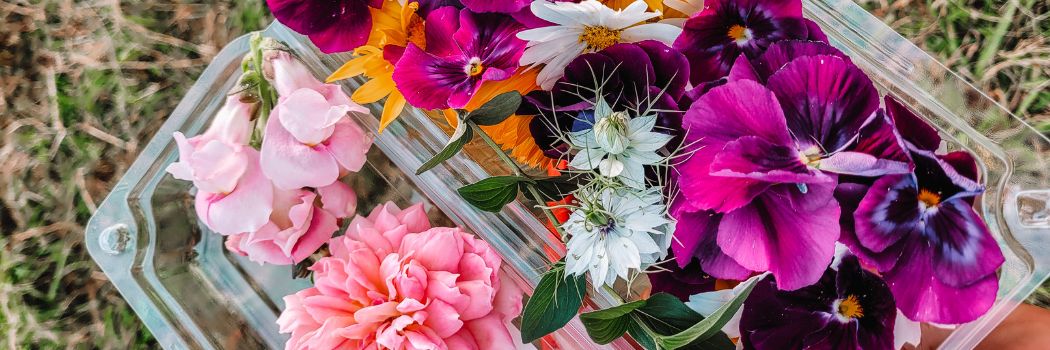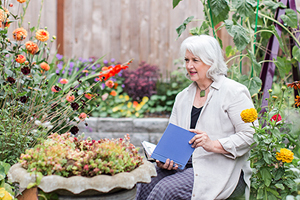- Johnny's Edible Flower Guide | Printable 4-pp Brochure (PDF)
- Edible Flower Varieties | Product List Insert (PDF)
- More Ideas for Edible Flowers (PDF)
- Edible Flower Recipes (PDF)
- Edible Flowers | Easy Choices for Salad Mix (PDF)
- Edible Flowers | Tech Sheet (PDF)
- Video: Growing Edible Flowers
- Video: Summer Squash Blossoms | Recommended Varieties for Edible Flower Production
- Eat Your Flowers: Serve Up That Wow Factor With Edible Flowers
- Edible Flowers List: Top 20 Favorites from the Slow Flowers Community
Eat Your Flowers: Serve Up That Wow Factor With Edible Flowers
By Debra Prinzing, Slow Flowers Society, January 2024
Interest in edible flowers has been part of the Slow Food scene for years, but offerings of locally-grown, organic, flavorful—and pretty—edible blooms have been a bit slow to catch up to meet demand from the culinary crowd. Edible flowers enhance the sensory appeal of what we eat and drink and they have special relevance for vegetarian and vegan menus.
The Business Case For Growing Edible Flowers
Growing and marketing tasty blooms taps into a value-added category for food and flower farms. Edible flower collections give growers and designers a way to diversify and cross into the hospitality, event, and specialty food markets—chefs, bakers, and mixologists are hungry for colorful, nutritious blooms to enhance their recipes and concoctions. The barrier to entry is low when you can grow and sell varieties like borage, nasturtium, geranium, marigold, dianthus, calendula, viola, pansy and other tasty blooms that feed body and soul.
At The Marigold Gardens in Ithaca, New York, Caitlin Mathes grows only one type of flower: marigolds. "One of the many beautiful things about marigolds is that they are edible, and have always been used that way. To me, they taste a little like lettuce just before it bolts with maybe a slight citrus or spice note—and visually, the sunny, celebratory energy of marigolds is undeniable," she says. Caitlin supplies bakers, chefs, and caterers with "petalled sunshine," as she describes her favorite edible flower. It's a garnish that matches the color of Aperol Spritz, and a local chef uses her marigolds in a glaze and as a garnish for a special donut named the ‘Golden Garden.’
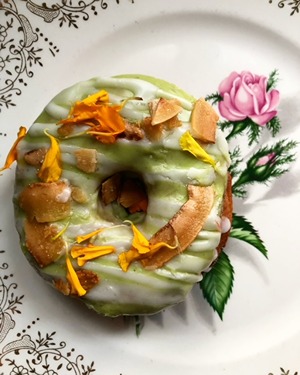
In the 2024 Slow Flowers Society member survey, we learned that just over one-third (37%) of our respondents grow edible flowers as part of their crop mix. Many floral varieties are suitable for human consumption, meaning that edible blooms are readily available from almost any grower, even if they are not marketed as such.
Edible Flowers Are Having a Moment: Increasing Demand For Edible Flowers
The French food blog Chefclub declared 2022 the year of edible flowers, citing the Slow Flowers Movement, and the momentum has continued. "With an average of 107k queries typed each month into Google worldwide, the term 'edible flowers' doubled compared to 2019," the blog publishers wrote, adding: "Local producers are making the choice to grow edible flowers, feeding a local market that respects the ecosystem and the seasons. It must be said that the field of possibilities is vast.”
Transparency Market Research found upward growth through 2028 in the global edible flowers market. "One of the key reasons supporting this growth is increasing demand from food incubators and restaurants, which want flowers suitable for human consumption, not to mention a growing awareness about the health benefits of edible flowers."
The researchers predicted growth in demand for edible flowers for these reasons:
- The desire for photogenic food
- The use of flowers such as lavender, hibiscus, dandelion, and roses as taste enhancers, effect magnifiers, and sources of additional fragrances
- The use of petal garnishing is a decorative trend
- The artful presentation of cocktails, lattes, sparkling drinks, and teas immersed with edible flowers
In our recent Slow Flowers member survey, we asked growers to rank their sales channels for edible blooms. Respondents cited the following outlets:
Opening Doors to New Markets
Edible flowers open doors to new markets—and many growers are leveraging this opportunity. If you already have environmentally sustainable practices in place, then the flowers you are already growing are safe and marketable as edible flowers.
We followed up with several growers to learn more about their programs and offerings, only to learn there are many ways to leverage interest in the category. Here’s a roundup of those insights:
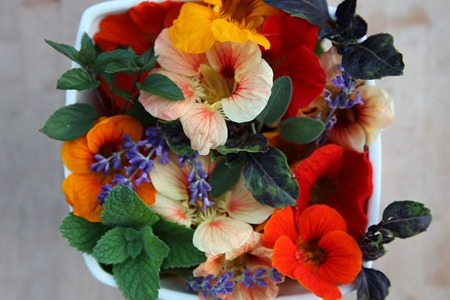
Dual-Purpose Flowers
Can a floral variety be sold two ways to maximize its usefulness as a crop? This is a popular approach to dried flowers, with farmers selecting varieties that are equally valuable when sold fresh or harvested to dry for off-season sales. Similarly, when an annual, herb, perennial, or other flowering blooms are marketable as both a cut flower and an edible flower, opportunities to monetize a crop are multiplied.
At Field to Heart in Curtis, Washington, Dannielle (Dee) Swan and Valiant Poole look for dual-purpose flowers, which they call “bilingual.” “We love varieties that have more than one sales point,” Dee says.
The farm sells primarily to florists through the Seattle Wholesale Growers Market. “Edible flowers are time-consuming, so I would rather harvest to fulfill a specific order.”
Field to Heart sells 30 to 40 small flowers (violas and bachelors’ buttons) for $15 and larger packages of 100 flowers (such as nasturtiums) for $30 to $40. When a restaurant or bar purchases a half-dozen large clamshells each week, the order justifies the extra labor to harvest, Dee explains.
One challenge is to keep edible flowers as a top-of-mind option for customers. “My goal is to have a little wine cooler at the Growers Market so our edible flowers are more visible. Ideally, the flowers will sell better if they are present, chilled, and in good condition. Plus, they are fun and whimsical.”
Harvesting Edible Flowers
Labor Considerations
Harvesting edible flowers is time-consuming and there is an acknowledged level of “perfection” required for edible blooms, farmers say. At Field to Heart, Dee and Valiant noticed tiny insect bites on the violas and pansies growing in their high tunnel, so they moved those crops to large planters on the upper balcony of their home—far above the ground.
“Most edible flowers are low-growing and you find yourself kneeling or crouching,” to harvest, observes Sarah Wagstaff of SUOT Farm and Flowers in Burlington, Washington. “On the plus side, most are so abundant and tiny, so there’s an opportunity to grow a lot of them in a smaller space.”
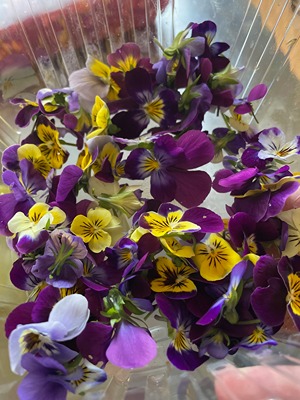
Time-Savings Strategies
One time-saving strategy is to harvest flowers straight from plant into a clamshell. Sarah packages the edible blooms in food-grade clamshell containers (made from recycled plastic), purchased from a restaurant supplier. “I hate packaging in plastic, but if you’re going to put edible flowers into refrigeration, you need to hold in moisture. I always put a slightly wet paper towel in the clamshell for this purpose.” Her edible packages are sold for $14, varied by the flower sizes. For example, the same clamshell can hold either 50 small violas or 10 nasturtium blooms.
She notes that small blemishes aren’t noticeable once a flower’s petals or blooms are dried. For example, dried edible flowers or petals (such as calendula and lavender) can be used in desserts, baking, or cocktail infusions where the full bloom isn’t needed to complete a recipe.
Sales & Marketing Strategies
Edible Flower Bento Boxes
Christian Ingalls of Daisy Duke's Flower Farm on Hawaii's Big Island believes that her edible flowers open doors to new markets. She markets Flower Bento boxes for $10 each, with a mix of up to 22 edible varieties, packaged in a biodegradable container. "They're perfect for birthdays, weddings, baking, or wanting to add something fun to your dinners," she says.
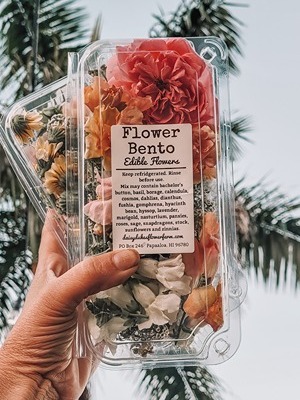
A Value-Added Proposition
Diane Glock-Cornman of Lavender and Locks in Elizabethtown, Pennsylvania, supplies two types of fresh English lavender to bakeries and coffee shops for special promotions. She also sells pansy, snapdragon, stock, marigold, and various mints (chocolate and apple) to culinary customers. While the income from edible flowers sales isn’t large, “I look at it as a value-added marketing project, because edible flowers get our name out in the community,” she notes.
Edible Bouquets
Jodi Logue of Moss & Madder Farm in Olalla, Washington, sells her flowers to a charcuterie board business and to a chef who caters yoga retreats. Rather than harvesting the flower heads for packaging, Jodi often delivers bouquets of edible flowers, which allows the customer to clip blooms as needed—extending their freshness. “I don’t have special pricing for edible flowers; I just charge what I would for a market bouquet.”
Lavender and Locks has a similar strategy for its grocery store customers, creating all-edible market bouquets with herbs and flowers, adding a featured recipe tag to the product.
At Alethia Fields in Bluff City, Tennessee, Tina Gregg employs a similar strategy, which she began in response to requests from local chefs. “It piqued my interest and I slowly started incorporating edible varieties onto the farm. There are so many flowers that you can eat! The chefs buy our flowers by the bucket or bunch, which helps the blooms stay fresh if they’re not going to be used right away.”
Tina’s edible flower collection includes Tulsi, calendula, bachelors’ buttons, lavender, snapdragon, dahlia, anise hyssop, mountain mint, butterfly pea flower, feverfew, stock, zinnia, nigella, cosmos, and hibiscus. Making edible flower lollipops or supplying restaurants is a small part of the farm’s revenue, but Tina sees the potential for using edible flowers for other purposes, such as a future product line of floral tea blends.
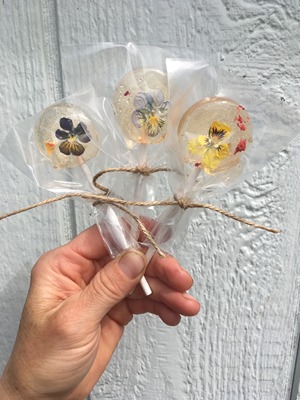
Collaboration with Agritourism Partners
Moss & Madder Farm recently joined a local agritourism coalition, which has connected Jodi with Slow Food vendors, farm-to-table venues, and potential partners for her farm and flowers. “A lot of my focus is telling people that I have edible flowers,” she says. “It’s so fun to educate others about what is edible because I think at least half of the flowers I grow are edible.”
Edible Flowers for Events
On-farm special events at Alethia Fields, including tours and classes, are successful, and Tina Gregg has found a fun way to include edible flowers. “We started having birthday parties, mainly for little girls,” Tina explains. “They receive a farm tour, get to make their own small arrangement, and they decorate their cupcakes with edible flowers. I keep a stock of pressed edible flowers for them to use—it’s always a fun activity.”
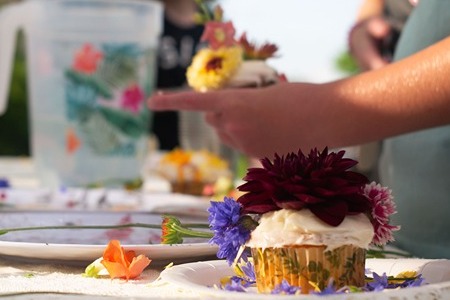
Why Grow Edible Flowers?
“The goal for my business is to reconnect people with nature over and over again,” Sarah Wagstaff maintains. “Sprinkling flowers into people’s lives reminds them of the seasons. Edible flowers provide delight, beauty, and nuanced flavor.”
Learn More
Additional Resources from Johnny's
- Shop our complete selection of edible flower varieties …
- Edible Flowers Guide • (PDF)
- Edible Flowers Tech Sheet • (PDF)
- Edible Flowers List: Top 20 Favorites from the Slow Flowers Community
Resources For Cooking With Edible Flowers
Find culinary inspiration from two new books:
- "The Edible Flower: A Modern Guide to Growing & Eating the Flowers in Your Garden," by Erin Bunting and Jo Facer (March 2023, Laurence King Publishing).
The authors, organic gardener Jo Facer and chef Erin Bunting, run a farm-to-fork supper club, and a cooking and gardening school called The Edible Flower, based in Northern Ireland. Their book features 40 flowers with 50 original recipes, as well as gardening advice, with a sustainable, plant-based focus.
They believe edible flowers should be integrated into everyone's field or studio: "They bring us joy. They are beautiful in the garden and beautiful when we use them in food. They bring pollinating insects into our garden in great numbers. We don't get many calories from edible flowers, but we get some unique flavors and a big helping of happiness."
- “Eat Your Flowers,” by Loria Stern (April 2023, Harper Collins Publishers)
The author shows readers how to transform botanical ingredients – root to stem – into more than 150 recipes that inspire creativity in the kitchen. The author is a Los Angeles-based culinary influencer whose bakery business, also called Eat Your Flowers, sells cookies, desserts and chocolates embellished with flowers that she grows in her tiny garden.


